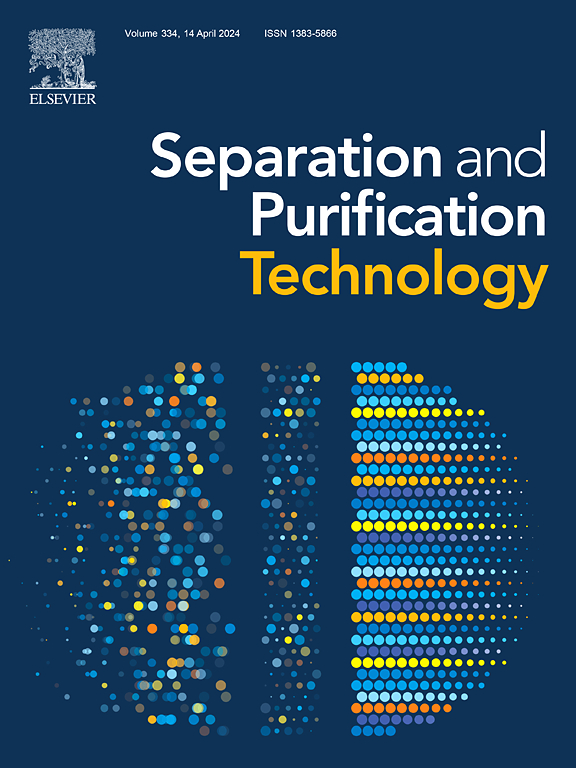铁(III)-三聚磷酸钠-活化H2O2对ph依赖性菲的降解:主要活性氧和配体的作用
IF 8.1
1区 工程技术
Q1 ENGINEERING, CHEMICAL
引用次数: 0
摘要
多环芳烃(PAHs)作为环境顽固性污染物在陆地、水生和大气基质中持续存在,对人类健康构成重大的致癌和诱变威胁。由于pH值的限制、铁污泥的产生和氧化剂效率差,传统的Fenton系统在碱性废水处理中面临局限性。本研究证明了三聚磷酸钠(STPP)增强的Fe(III)/H2O2体系在温和碱性条件下(pH 9.0)可有效降解菲(去除率为95.4 %)。机制研究表明,STPP通过P=O键配位Fe(III),形成稳定的[Fe(HmP3O10)2]n -配合物,防止铁沉淀并维持氧化还原循环。优化后的Fe(III)/STPP/H2O2摩尔比(1/1/20)的表观动力学常数(kobs)为2.8 × 10−2 min−1,比传统的Fenton体系提高了31倍。该系统在pH 7.0-9.0范围内保持功效,表现出对常见阴离子的抗性,同时对Ca2+/Mg2+浓度升高(500 mg/L)表现出敏感性。活性氧(ROS)分析揭示了ph依赖性机制:酸性条件下羟基自由基(•OH)占优势,碱性条件下单线态氧(1O2)通过H2O2 → O2•−→1O2转化为主。密度泛函理论计算证实,碱性OH−促进H2O2活化成O2•−,促进了1O2的生成。三个降解途径涉及羟基化和环切割产生毒性较小的中间体。这种stpp修饰的Fenton工艺能够在碱性废水中实现o2驱动的多环芳烃氧化,克服了传统Fenton的限制。所开发的技术表明,通过配体增强ROS生成,可持续修复多环芳烃污染废水具有巨大潜力。本文章由计算机程序翻译,如有差异,请以英文原文为准。


pH-dependent phenanthrene degradation by Fe(III)-sodium tripolyphosphate-activated H2O2: dominant reactive oxygen species and roles of ligands
Polycyclic aromatic hydrocarbons (PAHs) persist as environmentally recalcitrant contaminants across terrestrial, aquatic, and atmospheric matrices, posing substantial carcinogenic and mutagenic threats to human health. Conventional Fenton systems face limitations in alkaline wastewater treatment due to pH constraints, iron sludge generation, and poor oxidant efficiency. This study demonstrates a sodium tripolyphosphate (STPP)-enhanced Fe(III)/H2O2 system achieving effective phenanthrene degradation (95.4 % removal) under mild alkaline conditions (pH 9.0). Mechanistic investigations reveal that STPP coordinates Fe(III) through P=O bonding, forming stable [Fe(HmP3O10)2]n− complexes that prevent iron precipitation and sustain redox cycling. The optimized Fe(III)/STPP/H2O2 molar ratio (1/1/20) delivered an apparent kinetic constant (kobs) of 2.8 × 10−2 min−1, representing a 31-fold enhancement over conventional Fenton systems. The system maintained efficacy across pH 7.0–9.0, showing resistance to common anions while exhibiting sensitivity to elevated Ca2+/Mg2+ concentrations (500 mg/L). Reactive oxygen species (ROS) analysis revealed pH-dependent mechanisms: hydroxyl radicals (•OH) predominated under acidic conditions, while singlet oxygen (1O2) became primary under alkalinity through H2O2 → O2•−→1O2 conversion. Density functional theory calculations confirmed that alkaline OH− promotes H2O2 activation to O2•−, facilitating 1O2 generation. Three degradation pathways involving hydroxylation and ring cleavage produced less toxic intermediates. This STPP-modified Fenton process enables 1O2-driven PAH oxidation in alkaline wastewater, overcoming conventional Fenton limitations. The developed technology demonstrates significant potential for sustainable remediation of PAH-contaminated wastewater through ligand-enhanced ROS generation.
求助全文
通过发布文献求助,成功后即可免费获取论文全文。
去求助
来源期刊

Separation and Purification Technology
工程技术-工程:化工
CiteScore
14.00
自引率
12.80%
发文量
2347
审稿时长
43 days
期刊介绍:
Separation and Purification Technology is a premier journal committed to sharing innovative methods for separation and purification in chemical and environmental engineering, encompassing both homogeneous solutions and heterogeneous mixtures. Our scope includes the separation and/or purification of liquids, vapors, and gases, as well as carbon capture and separation techniques. However, it's important to note that methods solely intended for analytical purposes are not within the scope of the journal. Additionally, disciplines such as soil science, polymer science, and metallurgy fall outside the purview of Separation and Purification Technology. Join us in advancing the field of separation and purification methods for sustainable solutions in chemical and environmental engineering.
 求助内容:
求助内容: 应助结果提醒方式:
应助结果提醒方式:


